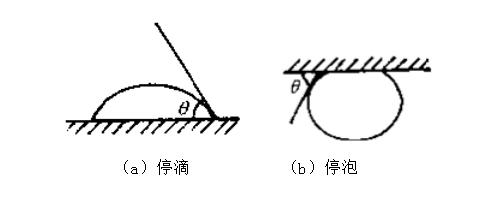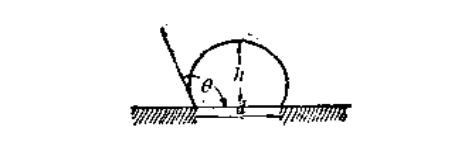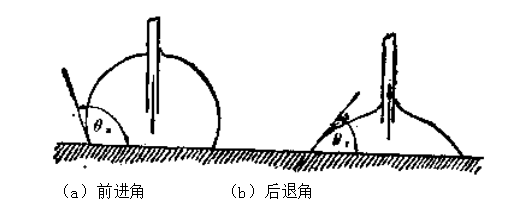The contact angle refers to the tangent of the gas-liquid interface made at the intersection of the gas, liquid and solid three phases, passing through the angle between the liquid and the solid-liquid interface, and is the main means to characterize the surface wettability of the material;
The main measurement methods are: measuring angle method, measuring height method, contact angle measuring instrument measurement (sessile drop method, pendant drop method, thin film method, captive bubble method, coated fiber method, fiber sessile drop method, attached drop method), the following One by one for everyone to analyze the contact angle measurement method.
First, the angle method to measure the contact angle
Droplet angle measurement is one of the most commonly used methods to measure the contact angle, as shown in Fig. 1(a,b). The method is to project the droplet on the solid surface or the bubble formed on the solid surface immersed in the liquid onto the screen, and then directly measure the angle between the tangent and the phase interface, and directly measure the size of the contact angle.

Figure 1 Schematic diagram of the angle measurement method
If the liquid vapor adsorbs on the solid surface and affects the surface free energy of the solid, the sample should be placed in a sealed box with an observation window, and the measurement should be performed after the system reaches equilibrium. The advantages of this method are: less sample consumption, simple instrument and convenient measurement. The accuracy is generally about ±1°.
2. Measurement of contact angle by height method
If the droplet is small, the deformation of the droplet caused by gravity is negligible, and the lying droplet can be considered as part of a spherical shape, as shown in Figure 4. The contact angle can be calculated from the height measurement as follows:
(1)
where h is the height of the droplet and d is the diameter of the bottom of the droplet. This method can be used if the droplet volume is less than 10-4mL. If the contact angle is less than 90o, slightly larger droplets can also be used.

Figure 2 Schematic diagram of the volume height method
The contact angle of the droplet on the fiber can also be measured by goniometric method, and the fiber is straightened horizontally. It is placed in the sample tank and projected onto the computer screen to directly measure the angle between the droplet and the fiber surface. If the droplet is small, the contact angle can also be measured by the high-volume method and calculated by formula (1).
The actual solid surface is almost always non-ideal, and there is always a contact angle hysteresis phenomenon whether it is large or small. Therefore, it is necessary to measure the advancing angle and the receding angle at the same time. For the lying drop method, it can be determined by increasing or decreasing the drop volume. The advancing angle is measured when the droplet volume is increased, as shown in Fig. 3(a); the receding angle is measured when the droplet volume is decreased, as shown in Fig. 3(b).

Figure 3 Measuring method of advancing angle and receding angle
3. Contact angle measuring instrument to measure the contact angle
1. Diversified contact angle analysis methods: automatic fitting method, semi-automatic fitting method, manual level measurement, manual slope measurement;
2. Diversified software calculation methods: ring fitting method (below 40 degrees); ellipse fitting method (40-120 degrees); Young-Lapalacer fitting method (above 120 degrees);
3. Accurate surface free energy calculation: Fowks method, OWRK method, ZismanPlot method, EOS method (partial liquid database pre-installed in the software, expandable);
4. One-button software measurement operation: turn on the camera; the software precisely controls the dripping; the software performs automatic measurement with high precision;
5. Irregular product measurement expansion: concave and convex surface measurement, curved surface measurement, rolling angle measurement, advancing angle receding angle measurement, high temperature contact angle measurement;
6. High-speed camera mode: single/continuous/video; video can be exported as a single film; video can be automatically and quickly measured;
7. Detailed database management: export Excel table data, word picture data; picture text is obvious.
With the progress of the times, the measurement of the contact angle is basically obtained through the instrument, because the manual calculation error is large, but different contact angle measuring instruments also have different precisions, everyone should pay attention to choosing the regular one when choosing. Big brands, such as Sindin Precision's contact angle measuring instrument, have comprehensive, complete, and high-precision fitting methods on the market, which are suitable for contact angle measurement and analysis of any material surface.



